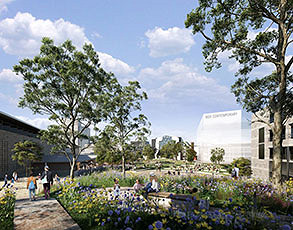Council signals attitude “shift” on public art
New public art in Melbourne will be informed by a more Aboriginal rather than Eurocentric view and will be considered before — rather than after — big projects are built.
The changes are part of several “shifts” in the City of Melbourne’s public art program, which also sought to commission works that were intrinsically “Melbourne” and are more “bold, dynamic and ambitious”.
The 10-year Public Art Framework (2021-31) sets out clearer purpose and principles for future investment in the space, according to the council.
Feedback from stakeholders indicated, among other suggestions, that the council should prioritise creative works led by Aboriginal or Torres Strait Islanders.
Cr Rohan Leppert said the city’s cultural richness meant it would not settle for second-best.
“This is a bold framework,” he said at a November 23 council meeting.
“We do not do what other municipalities and other capital cities do; we have, for a very long time, strived for unique art that is conceived of from scratch, considering the place that the art is proposed to be placed in. We are not a council that receives off-the-shelf commissions and could plonk them anywhere.”
Cr Leppert, who prior to this council term spent eight years in the arts portfolio, said Melbourne should be picky with the public art it invested in.
“This is a city that thinks very carefully about what we need to do [and] what policy settings we need to have in place in order to produce unique art that’s distinctly Melbourne, that is informed not only by a Eurocentric view but is informed by generations of an Aboriginal world view, [and asking] what does that actually mean for how we commission art and where we put public art,” he said.
There was also an economic focus to the new public art framework.
A report earlier this year identified that the creative industries could help drive Melbourne’s economic recovery, and that for every $1 million invested in “creative programming”, there would be a return of $4.5 million (once border restrictions had lifted).
“It’s not just about demonstrating the creative output of our city or of the artists themselves — a lot of this work very much needs to drive visitation,” Cr Elizabeth Doidge said.
Not to put art into an economic context and say, ‘that’s what it’s all about’, but I don’t want to skip over the importance of public art in bringing people into the city.
Cr Doidge, the council’s deputy chair of the Creative Melbourne portfolio, said it was also about equity of support.
“Art and entertaining took a massive hit throughout the pandemic, and those industries weren’t supported in the same way hospitality and other sectors have been. So, I think the deliverables in this public art framework will do a lot to bring artists back into the city and getting them working again.”
Last month Southbank News revealed that a major upcoming public artwork on Dodds St was set to dramatically exceed the original $2 million price tag.
The public piece, set to be located next to the Victorian College of the Arts (VCA), has had few public updates, and little is known about the work or artist.
However, it was understood that the council had opted to invest significantly higher than the $2 million figure originally announced for the showpiece work.
The project was approved by the council almost four years ago in February 2018, and an artist was expected to be announced in August that year.
However, when appointing the artist, it is understood the council chose to significantly increase the scope of the project, which has contributed to the delay.
At this stage the council remained tight-lipped on the project, and a spokesperson said it would simply be completed “in the coming years”.
The public work is set to be the first of four major public art commissions in Southbank.
More funding for arts upgrade
The city’s new public art framework came shortly after the state government announced an additional $241 million for the now $1.7 billion Melbourne Arts Precinct transformation.
The additional funding will see two new restaurants and bars built at the northern end of new public parkland that will connect Hamer Hall to the new NGV Contemporary.
Arts Centre Melbourne CEO Claire Spencer said the new dining areas would “transform the visitor experience”.
The announcement also included additional funding for improved acoustics, accessibility, and seating at the State Theatre.
The 1984-built theatre is set to be closed for more than two years as part of the government’s “fast-tracked” investment in the space.
Construction work on NGV Contemporary is underway •

Sally Capp: one last chat as Lord Mayor of Melbourne







 Download the Latest Edition
Download the Latest Edition